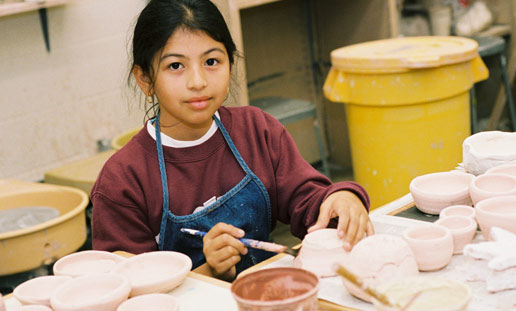The most important part of this blog (so far) is obviously service. That is the assignment after all. Sharing an experience I had at the art museum is difficult, though, because I’ve had so few. Causally, I’m going to share an experience instead.Two weeks ago, I went to the Art Museum under false pretenses. I believed that I was going to ‘serve’, when in fact the favor was reversed. If I was an indebted servant, this would be much like being given a day off, only to have the money for that day added to my debt. Luckily I’m not. Emily and I arrived at the Art Museum only to be told to stand in the back of the teaching room. It was a sunny day, and all the windows made it a bit stuff. We lolled about telling jokes and making fun of those too lazy to join us for the day, waiting for our assignment. There were T-shirts on the table, and we, or at least I, thought that we’d be printing them. We did not, however. Instead, Andy made an announcement. He told the class-and we two-that there was a puppet show in the Learning Room, and that if we were good, we’d be allowed to go see it. Additionally, if we were bad, we’d be taken out so fast our heads would spin. Since I possess an irrationally strong attachment to keeping my head much in the same position relative to my body, an attachment I find many others share, Emily and I headed into the puppet show like the meek lambs we are.
 It was a one
man puppet show, which made it interesting, notably because he was not a
ventriloquist. His name was Michael Gunst, and he was a performing artist. He had created the whole show, the backdrop, the puppets, even the music. He
performed his piece with a reverence often assumed for church. His masks were
amazing. He told us the story of the Wabanaki, a Native Aerican tribe in the
Northeast. The four protagonists, much like those of the proverbial Wizard of
Oz, set out to meet their God, in the hopes that he would grant their wishes.
Three failed because they didn’t follow his instructions. One succeeded because
he did. It was rather interesting, because if it had been a biblical tale,
there would’ve been sins associated with the failure, but there weren’t
It was a one
man puppet show, which made it interesting, notably because he was not a
ventriloquist. His name was Michael Gunst, and he was a performing artist. He had created the whole show, the backdrop, the puppets, even the music. He
performed his piece with a reverence often assumed for church. His masks were
amazing. He told us the story of the Wabanaki, a Native Aerican tribe in the
Northeast. The four protagonists, much like those of the proverbial Wizard of
Oz, set out to meet their God, in the hopes that he would grant their wishes.
Three failed because they didn’t follow his instructions. One succeeded because
he did. It was rather interesting, because if it had been a biblical tale,
there would’ve been sins associated with the failure, but there weren’t.
 It was so unusual I actually tried to stretch the
characters boundaries in a partial attempt to relate them to something I know.
One wished for possessions, which could easily be linked to greed. One wished
to be tall, perhaps out of vanity? Perhaps to have power over others? The other
one, however, confounds me. He wished to live a long time. Is that cowardice?
Is cowardice a sin? Is it also vanity, because he wished to know the time of
his death? It shouldn’t be, he didn’t ask for exact figures. Even the motives of the one who succeeded were
suspect. He wanted to be the world’s greatest hunter. He didn’t specify that he
would feed his family, or that he even had a family. Should it be taken for
granted? Was there a deeper meaning to the story, or was it simply, ‘follow
directions’? Much like a djinn, however, their god still granted their wishes,
even if they didn’t follow instructions. The one who wanted possessions sank in
a river, because his boat became so full. The tall one became a tree, the one
who wished for long life became a rock. While their motives interest me, and
perhaps you, my dear reader, the most important thing I learned wasn’t from the
story teller. It was from the children.When the story ended, they asked what happened to
all of the characters. This isn’t shocking, I know, someone is never paying
attention. However, all of them? All of them have such little comprehension
that they couldn’t grasp what was inferred to in a twenty minute puppet show,
with only six characters? I was more than confounded. It became a combination
of depression and hatred for the human race. Do we fail our children that much?
Andy said that the ones who ask questions do better on their standardized
tests, because they eventually learn. I couldn’t believe it. They actually have
trouble with standardized tests? There is no reason to have trouble with
standardized tests. They’re in English, and even if you have issues with Math Reading,
in Elementary school, is relatively straight forward. If you don’t speak
English, they offer it in other languages. How do you still have issues?The Art Museum is teaching me things after all. That
day, I came into contact with a part of the population I rarely see. I learned
that the issues the teachers I know complain of aren’t exaggerations, due to
the fact that they see so many kids. I learned that children do need our help.Additionally, Gunst, the puppeteer, responded to their
questions by asking them what they thought happened. My relatives did this to
me when I was young. You have several choices. If you didn’t know the answer to
the question you asked, you can make something up. If you do know the answer,
you can say it, or withdraw your question. These children wouldn’t make their
own answers. I don’t know if it was because they were shy, and making things up
isn’t ‘cool’, or if their imagination is really so lacking. I will choose to
believe the former.
It was so unusual I actually tried to stretch the
characters boundaries in a partial attempt to relate them to something I know.
One wished for possessions, which could easily be linked to greed. One wished
to be tall, perhaps out of vanity? Perhaps to have power over others? The other
one, however, confounds me. He wished to live a long time. Is that cowardice?
Is cowardice a sin? Is it also vanity, because he wished to know the time of
his death? It shouldn’t be, he didn’t ask for exact figures. Even the motives of the one who succeeded were
suspect. He wanted to be the world’s greatest hunter. He didn’t specify that he
would feed his family, or that he even had a family. Should it be taken for
granted? Was there a deeper meaning to the story, or was it simply, ‘follow
directions’? Much like a djinn, however, their god still granted their wishes,
even if they didn’t follow instructions. The one who wanted possessions sank in
a river, because his boat became so full. The tall one became a tree, the one
who wished for long life became a rock. While their motives interest me, and
perhaps you, my dear reader, the most important thing I learned wasn’t from the
story teller. It was from the children.When the story ended, they asked what happened to
all of the characters. This isn’t shocking, I know, someone is never paying
attention. However, all of them? All of them have such little comprehension
that they couldn’t grasp what was inferred to in a twenty minute puppet show,
with only six characters? I was more than confounded. It became a combination
of depression and hatred for the human race. Do we fail our children that much?
Andy said that the ones who ask questions do better on their standardized
tests, because they eventually learn. I couldn’t believe it. They actually have
trouble with standardized tests? There is no reason to have trouble with
standardized tests. They’re in English, and even if you have issues with Math Reading,
in Elementary school, is relatively straight forward. If you don’t speak
English, they offer it in other languages. How do you still have issues?The Art Museum is teaching me things after all. That
day, I came into contact with a part of the population I rarely see. I learned
that the issues the teachers I know complain of aren’t exaggerations, due to
the fact that they see so many kids. I learned that children do need our help.Additionally, Gunst, the puppeteer, responded to their
questions by asking them what they thought happened. My relatives did this to
me when I was young. You have several choices. If you didn’t know the answer to
the question you asked, you can make something up. If you do know the answer,
you can say it, or withdraw your question. These children wouldn’t make their
own answers. I don’t know if it was because they were shy, and making things up
isn’t ‘cool’, or if their imagination is really so lacking. I will choose to
believe the former.


